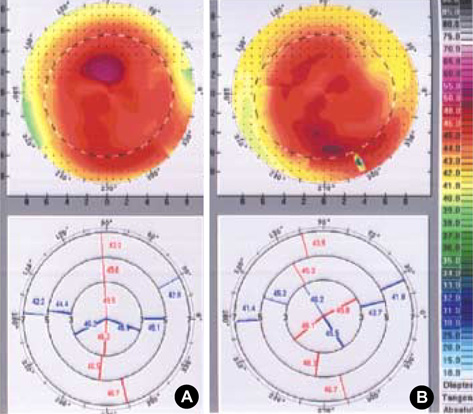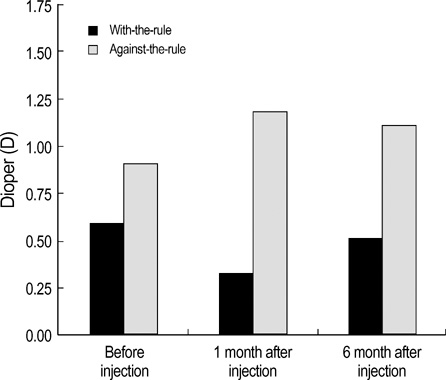J Korean Med Sci.
2006 Feb;21(1):131-135. 10.3346/jkms.2006.21.1.131.
The Changes in Corneal Astigmatism after Botulinum Toxin-A Injection in Patients with Blepharospasm
- Affiliations
-
- 1Department of Ophthalmology, College of Medicine, Chung-Ang University, Seoul, Korea. jck50ey@kornet.net
- KMID: 2157796
- DOI: http://doi.org/10.3346/jkms.2006.21.1.131
Abstract
- To determine if the involuntary contractions of eyelids may have any effects on the development of corneal astigmatism, we performed this prospective study which includes 19 patients with either essential blepharospasm or hemifacial spasm. In hemifacial spasm, the degree of corneal astigmatism was evaluated between two eyes. Then the topographic changes were checked using vector analysis technique before and after passively opening the eyelids. They were also measured before and at 1 and 6 months after the injection of Botulinum toxin. Resultantly, 20 eyes had the with-the-rule (group1) and 9 eyes against-the-rule (group2) astigmatism. In hemifacial spasm, significantly more astigmatism was found at spastic eyes. The corneal topographic changes after passively opening the eyelids showed 10 eyes with the astigmatic shift to the with-the-rule, while the remaining 19 to the againstthe- rule. At 1 month after injection of Botulinum toxin, group 1 showed reduced average corneal astigmatism, whereas group 2 showed increased astigmatism. The astigmatic change vector showed significantly more against-the-rule. In the contrary, 6 months after treatment, corneal astigmatism again increased in group 1 and decreased in group 2. So they took on the appearance of pretreatment astigmatic status eventually. Conclusively eyelids may play an important role in corneal curvature.
MeSH Terms
-
Aged
Astigmatism/*drug therapy/physiopathology
Blepharospasm/*drug therapy/physiopathology
Botulinum Toxin Type A/administration & dosage/*therapeutic use
Cornea/drug effects/physiopathology
Corneal Diseases/*drug therapy/physiopathology
Eyelids/drug effects/physiopathology
Female
Humans
Injections
Male
Middle Aged
Time Factors
Treatment Outcome
Figure
Reference
-
1. Stark L. Presbyopia in light of accommodation. Am J Optom Physiol Opt. 1988. 65:407–416.
Article2. Kang KH, Baek SH, Lee KS. Corneal astigmatic change in corneal topography after upper eyelid surgery. J Korean Ophthalmol Soc. 2002. 43:1113–1122.3. Cosar CB, Rapuano CJ, Cohen EJ, Laibson PR. Chalazion as a cause of decreased vision after LASIK. Cornea. 2001. 20:890–892.
Article4. Santa Cruz CS, Culotta T, Cohen EJ, Rapuano CJ. Chalazion-induced hyperopia as a cause of decreased vision. Ophthalmic Surg Lasers. 1997. 28:683–684.5. Novak KD, Kohnen T, Chang-Godinich A, Soper BA, Kennedy P, Wang Q, Padrick T, Koch DD. Changes in computerized videokeratography induced by artificial tears. J Cataract Refract Surg. 1997. 23:1023–1028.
Article6. Nemeth J, Erdelyi B, Csakany B, Gaspar P, Soumelidis A, Kahlesz F, Lang Z. High-speed videotopographic measurement of tear film build-up time. Invest Ophthalmol Vis Sci. 2002. 43:1783–1790.7. Handa T, Mukuno K, Niida T, Uozato H, Tanaka S, Shimizu K. Diurnal variation of human corneal curvature in young adults. J Refract Surg. 2002. 18:58–62.
Article8. Goto T, Klyce SD, Zheng X, Maeda N, Kuroda T, Ide C. Gender- and age-related differences in corneal topography. Cornea. 2001. 20:270–276.
Article9. Calace P, Cortese G, Piscopo R, Della Volpe G, Gagliardi V, Magli A, De Berardinis T. Treatment of blepharospasm with botulinum neurotoxin type A: long-term results. Eur J Ophthalmol. 2003. 13:331–336.
Article10. Gross RH, Miller KM. Corneal astigmatism after phacoemulsification and lens implantation through unsutured scleral and corneal tunnel incisions. Am J Ophthalmol. 1996. 121:57–64.
Article11. Jaffe NS, Jaffe MS, Jaffe GF. Cataract surgery and its complications. 1990. St Louis: CV Mosby;114–119.12. Suat HU, Guler Z. Corneal topography in patients with congenital ptosis. Eye. 1999. 13:550–554.
Article13. Lavy JA, East CA, Bamber A, Andrews PJ. Gold weight implants in the management of lagophthalmos in facial palsy. Clin Otolaryngol Allied Sci. 2004. 29:279–283.
Article14. Waller RR, Kennedy RH, Henderson JW, Kesty KR. Management of blepharospasm. Trans Am Ophthalmol Soc. 1985. 83:367–386.15. Smith J. Diurnal intraocular pressure: Correlation to automated perimetry. Ophthalmology. 1985. 92:858–861.16. Ehrmann K, Francis I, Stapleton F. A novel instrument to quantify the tension of upper and lower eyelids. Cont Lens Anterior Eye. 2001. 24:65–72.
Article
- Full Text Links
- Actions
-
Cited
- CITED
-
- Close
- Share
- Similar articles
-
- Influence of Botulinum Toxin A on Corneal Astigmatism
- Corneal Topographic Changes after Botulinum Toxin-A Injection in Patients with Essential Blepharospasm
- Treatment of Blepharospasm and Hemifacial apasm with Botulinum Toxin A(Oculinum(R))(I)
- Effects of Botulinum Toxin Combined with Diltiazem on Blepharospasm and Hemifacial Spasm
- Management of Essential Blepharospasm: Botulinum Toxin A Treatment and Orbicularis Myectomy Operation





